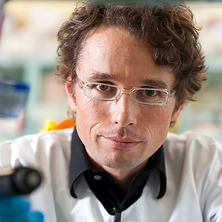
Overview
Background
I am a clinician scientist and academic leader with research in melanoma cell biology and experimental melanoma therapy. I received my degree in medicine from the University of Heidelberg, Germany (1990-1998). I graduated summa cum laude with a PhD in Cell Biology from the University of Heidelberg (1993-1999) and trained in clinical dermatology at the University of Hamburg, Germany (1999-2003). In 2003 I moved to Philadelphia, PA, to work as a post-doctoral fellow in Meenhard Herlyn’s lab at The Wistar Institute (2003-2007). From there I was recruited as an associate faculty member to the Centenary Institute/University of Sydney (2007-2013). In 2013 I commenced a position as Associate Professor for Cutaneous Oncology at University of Queensland Diamantina Institute (now Frazer Institute) and was promoted to full Professor in April 2016.
Availability
- Professor Nikolas Haass is:
- Available for supervision
Fields of research
Qualifications
- Doctoral Diploma, Ruprecht Karls Universität Heidelberg
Research impacts
Using cutting-edge technology, including real-time cell cycle imaging in 3D culture and in vivo, my team studies the role of dynamic melanoma heterogeneity in melanomagenesis with the goal to develop novel therapeutic approaches by simultaneously targeting different tumor cell subpopulations. My laboratory and our team are in the unique position to combine sophisticated imaging and biosensor approaches with biochemical methods to provide unprecedented insight to the mechanisms of tumor heterogeneity, tumor-stroma interactions and cancer immunology.
My contribution to the field is best evidenced by 97 original papers and invited reviews in leading biomedical journals. Many of our papers have a large impact in the field (>7500 citations in total, and 19 papers cited >100 times each). The papers in Mol Cancer Ther (2006, cited >500x), Cancer Res (2007, cited 265x) and PNAS (2008, cited 1500x) were evaluated by Faculty 1000 Biology as recommended or exceptional, respectively.
Works
Search Professor Nikolas Haass’s works on UQ eSpace
1996
Conference Publication
Tissue distribution and intracellular localization of the vesicle protein pantophysin.
Haass, NK, Kartenbeck, J, Heupel, SE, Marschall, A and Leube, RE (1996). Tissue distribution and intracellular localization of the vesicle protein pantophysin.. WILEY-LISS.
1996
Journal Article
Pantophysin is a ubiquitously expressed synaptophysin homologue and defines constitutive transport vesicles
Haass, N. K., Kartenbeck, J. and Leube, R. E. (1996). Pantophysin is a ubiquitously expressed synaptophysin homologue and defines constitutive transport vesicles. Journal of Cell Biology, 134 (3), 731-746. doi: 10.1083/jcb.134.3.731
Funding
Supervision
Availability
- Professor Nikolas Haass is:
- Available for supervision
Looking for a supervisor? Read our advice on how to choose a supervisor.
Supervision history
Current supervision
-
Doctor Philosophy
Assessment of cell cycle phase-dependent immunogenicity of melanoma treated with the proteasome inhibitor bortezomib
Principal Advisor
Other advisors: Professor Brian Gabrielli
-
Doctor Philosophy
Understanding the interplay of MITF, TFEB and CDK4/6 on lysosome activity in melanoma
Principal Advisor
Other advisors: Associate Professor Jason Lee
-
Doctor Philosophy
Modulating phenotypic melanoma heterogeneity and lymphocyte infiltration to improve both targeted and immune therapy
Principal Advisor
Other advisors: Professor Brian Gabrielli, Dr Janin Chandra
-
Doctor Philosophy
Proteomics and transcriptomics analysis of phenotypic heterogeneity in 3D melanoma spheroids
Principal Advisor
Other advisors: Dr Quan Nguyen, Associate Professor Helmut Schaider
-
Doctor Philosophy
Targeting epigenetic regulation to overcome immunotherapy resistance in cutaneous melanoma
Associate Advisor
Other advisors: Professor Kiarash Khosrotehrani, Dr Abbas Shafiee, Associate Professor Jason Lee
-
Doctor Philosophy
Strategies to improve immunotherapy for patients with glioblastoma or breast cancer brain metastases
Associate Advisor
Other advisors: Dr Jodi Saunus, Professor Fiona Simpson
Completed supervision
-
2023
Doctor Philosophy
Enhancing ER stress induced apoptosis and immunogenic cell death in melanoma
Principal Advisor
-
2019
Doctor Philosophy
Investigation of Microphthalmia-Associated Transcription Factor (MITF)-driven tumour heterogeneity in a 3D melanoma spheroid model in vitro.
Principal Advisor
Other advisors: Associate Professor Helmut Schaider
-
2023
Doctor Philosophy
The regulation of cGAS during cell cycle
Associate Advisor
Other advisors: Professor Paul Clarke
-
2022
Doctor Philosophy
Regulation of Microtubules in 3D by CLASPs
Associate Advisor
Other advisors: Associate Professor Samantha Stehbens
-
2017
Doctor Philosophy
Mechanisms and markers of CHK1 inhibitors sensitivity in melanoma
Associate Advisor
Other advisors: Professor Brian Gabrielli
Media
Enquiries
For media enquiries about Professor Nikolas Haass's areas of expertise, story ideas and help finding experts, contact our Media team:
